Posted by: Northwest Eye in General on October 27, 2025
Overview
This article addresses the concerns many may feel regarding heavy eyelids, offering effective solutions that include both surgical and non-surgical options. Procedures like blepharoplasty, alongside FDA-approved eye drops such as Upneeq, are highlighted as viable treatments. Evidence supports these options, showing improvements not only in appearance but also in vision.
We understand that managing heavy eyelids can be a personal journey, and it’s essential to consider personalized care tailored to your unique needs. Timely intervention is crucial to address the underlying causes effectively.
As you explore these options, remember that you are not alone. Many individuals have shared their experiences and found reassurance in the support offered by healthcare professionals. We are here to help you through this process, ensuring you feel informed and empowered every step of the way.
Introduction
Heavy eyelids can often feel like a burden, impacting both your appearance and vision. We understand that this can be frustrating and concerning. By recognizing the various causes—from aging and genetics to lifestyle factors—you can take the first step towards effective management strategies.
This article explores ten actionable solutions to help you. From non-surgical treatments like eye drops to surgical options such as blepharoplasty, we aim to provide you with insights into improving your eye health and addressing your aesthetic concerns.
But what happens when these symptoms are ignored? It’s common to overlook these issues, but the potential complications may surprise you. Ignoring these signs underscores the importance of timely intervention. We are here to help you through this process.
Northwest Eye: Comprehensive Treatments for Heavy Eyelids
At Northwest Eye, we understand that concerns about heavy eyelids can be deeply personal. That’s why we offer a broad range of therapies, combining sophisticated surgical and non-surgical alternatives to meet your unique needs. Blepharoplasty is a key surgical procedure that effectively removes excess skin and fat, enhancing both the appearance and functionality of your eyes. This rejuvenating procedure not only refreshes your look but also improves peripheral vision, making it a popular choice among many patients.
For those seeking immediate results without surgery, we provide non-surgical options like Upneeq, an FDA-approved eye drop that temporarily lifts heavy eyelids. This quick and effective solution can be a game changer for individuals looking for a fast fix.
Our commitment to patient-centered care means that every treatment plan is tailored specifically to you, focusing on enhancing your vision and overall eye health while addressing your individual concerns. We recognize that financial considerations are also important. To support you, we offer various financing options, making eye exams, vision tests, and treatments for conditions like cataracts more accessible.
With a blend of innovative methods and compassionate support, Northwest Eye stands out as a leader in treating heavy eyelids. We strive to ensure you receive the care you need without undue financial stress. It’s also important to consider that eyelid surgery may carry increased risks for older patients, so we encourage you to factor this into your decision-making process alongside financial considerations. Remember, we are here to help you through this process.
Identify Causes: Understanding Heavy Eyelids
We understand that heavy eyelids can stem from a variety of causes, and this can be concerning. Factors such as aging, genetics, and health issues like ptosis (droopy upper eyelids) and dermatochalasis (excess skin) can contribute to this sensation. A drooping upper lid, or ptosis, occurs when the upper lid falls lower than usual, potentially covering part of the pupil and affecting vision. This condition may arise from various factors, including thyroid eye disease and other lid issues like chalazion, ectropion, and entropion.
It’s common to feel overwhelmed, especially when lifestyle choices, such as lack of sleep and excessive screen time, lead to heavy eyelids. Recognizing these causes is crucial for understanding your condition. We want to reassure you that there are options available, including the possibility of blepharoplasty and its recovery process.
If you’re considering this path, know that you are not alone. Many have walked this journey and found relief. We are here to help you through this process, ensuring you feel supported every step of the way.
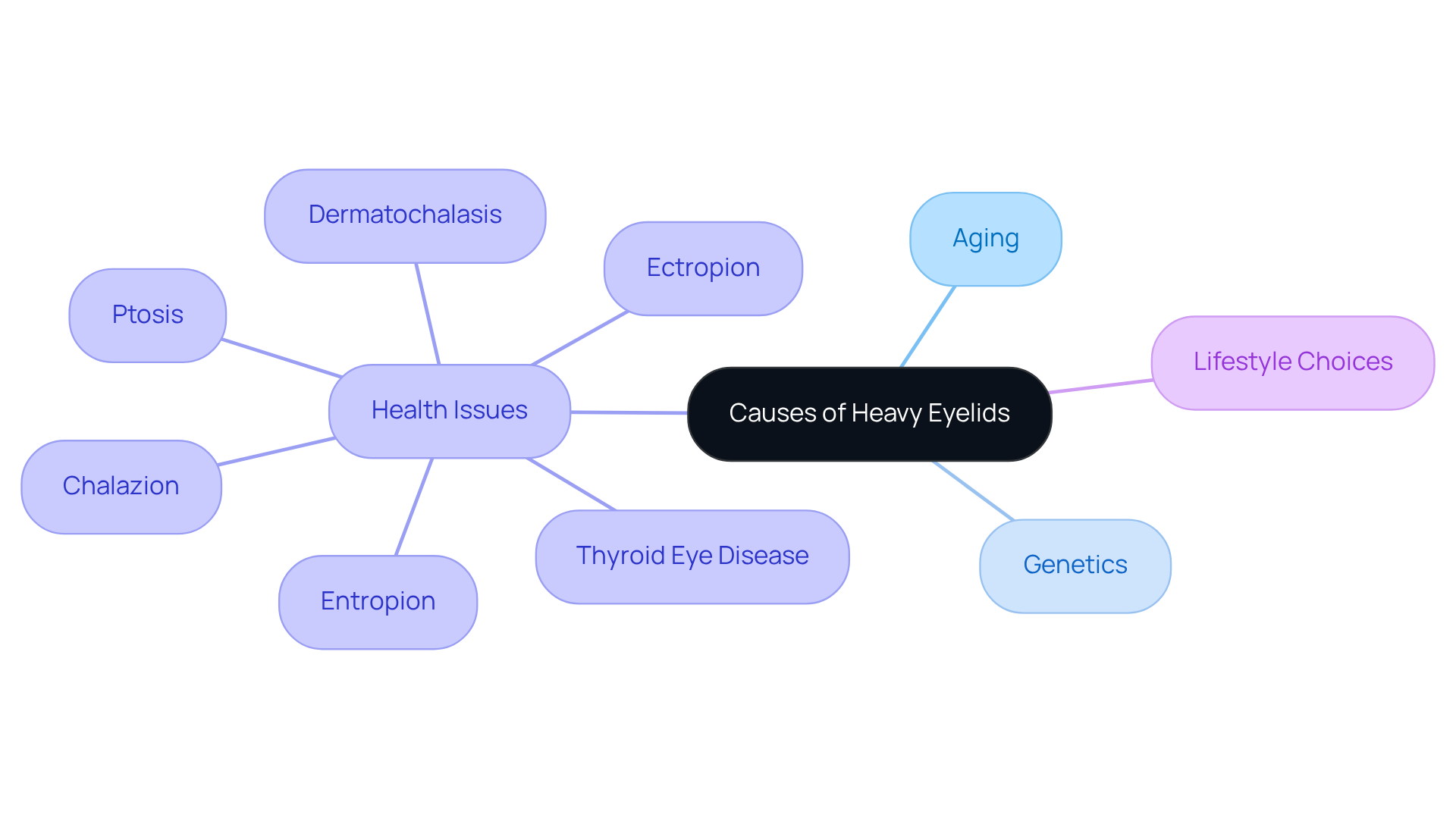
Explore Non-Surgical Treatments: Eye Drops and Lifestyle Changes
If you’re feeling weighed down by heavy eyelids, know that you’re not alone. Non-surgical therapies, like prescription eye drops such as Upneeq, can offer a quick lift for droopy lids, providing immediate relief for those seeking a swift solution.
We understand that lifestyle changes can also play a vital role in alleviating this discomfort. Improving your sleep quality, reducing screen time, and engaging in regular eye exercises can significantly enhance the comfort and function of your eyes. Research suggests that incorporating these exercises into your routine may improve muscle tone and help reduce drooping over time.
Additionally, simple practices like applying cold compresses or using green tea bags can soothe the area and reduce puffiness, offering a refreshing effect. By integrating these strategies into your daily life, you not only promote overall eye health but also address the aesthetic concerns related to heavy eyelids. Remember, we are here to help you through this process.
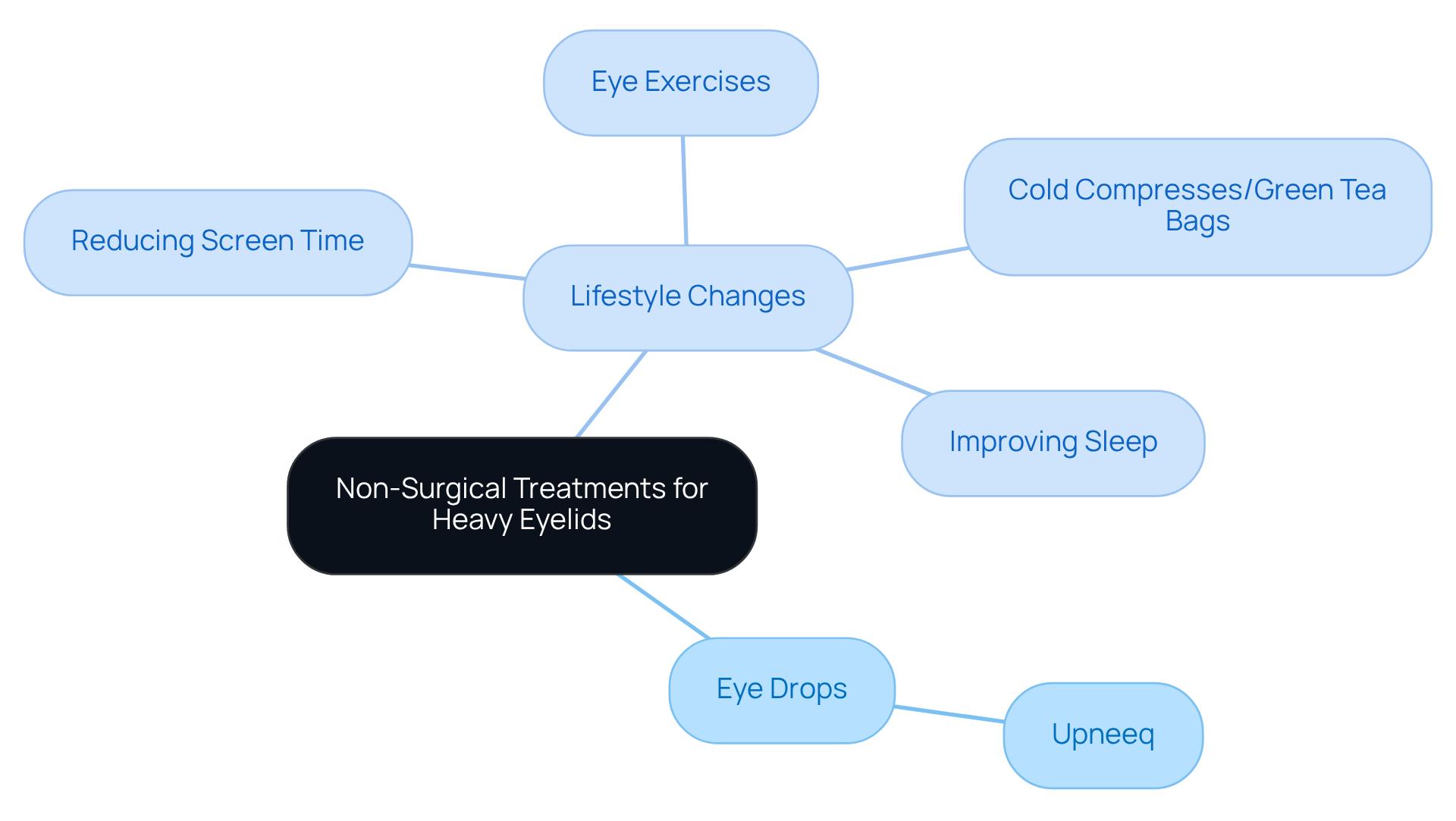
Consider Surgical Options: Eyelid Surgery for Heavy Eyelids
For individuals facing considerable sagging of the upper eyelid, resulting in heavy eyelids that affect both sight and appearance, we understand that surgical procedures like blepharoplasty can be a significant consideration. This procedure effectively eliminates surplus skin and fat from the area around the eyes, resulting in a refreshed look that helps reduce heavy eyelids and creates the more alert appearance that many desire. Typically conducted on an outpatient basis, blepharoplasty has an average recovery time of about one to two weeks. During this time, it’s common to experience temporary side effects like heavy eyelids, swelling, and bruising, which can be concerning.
The average expense of eyelid surgery in the U.S. is roughly $4,120, though this can differ depending on geographic area, with prices in Minnesota averaging about $4,540. Many individuals report improved peripheral vision and enhanced facial aesthetics following the procedure, which can be incredibly reassuring. Surgeons emphasize that choosing an experienced, board-certified plastic surgeon can significantly influence the outcome, leading to better results and a smoother recovery process. Dr. Gregory T. Mesna notes, “Choosing an experienced surgeon is crucial for achieving optimal results and minimizing complications.”
Case studies show that progress in surgical methods has enabled impressive outcomes, especially in tackling issues such as undereye bags and pronounced eyelids. This ensures that individuals feel content with their revitalized appearance. Additionally, surgery on the upper and lower lids may be covered by insurance if it is deemed to enhance peripheral vision, making it a feasible choice for many patients. We are here to help you through this process, providing support every step of the way.
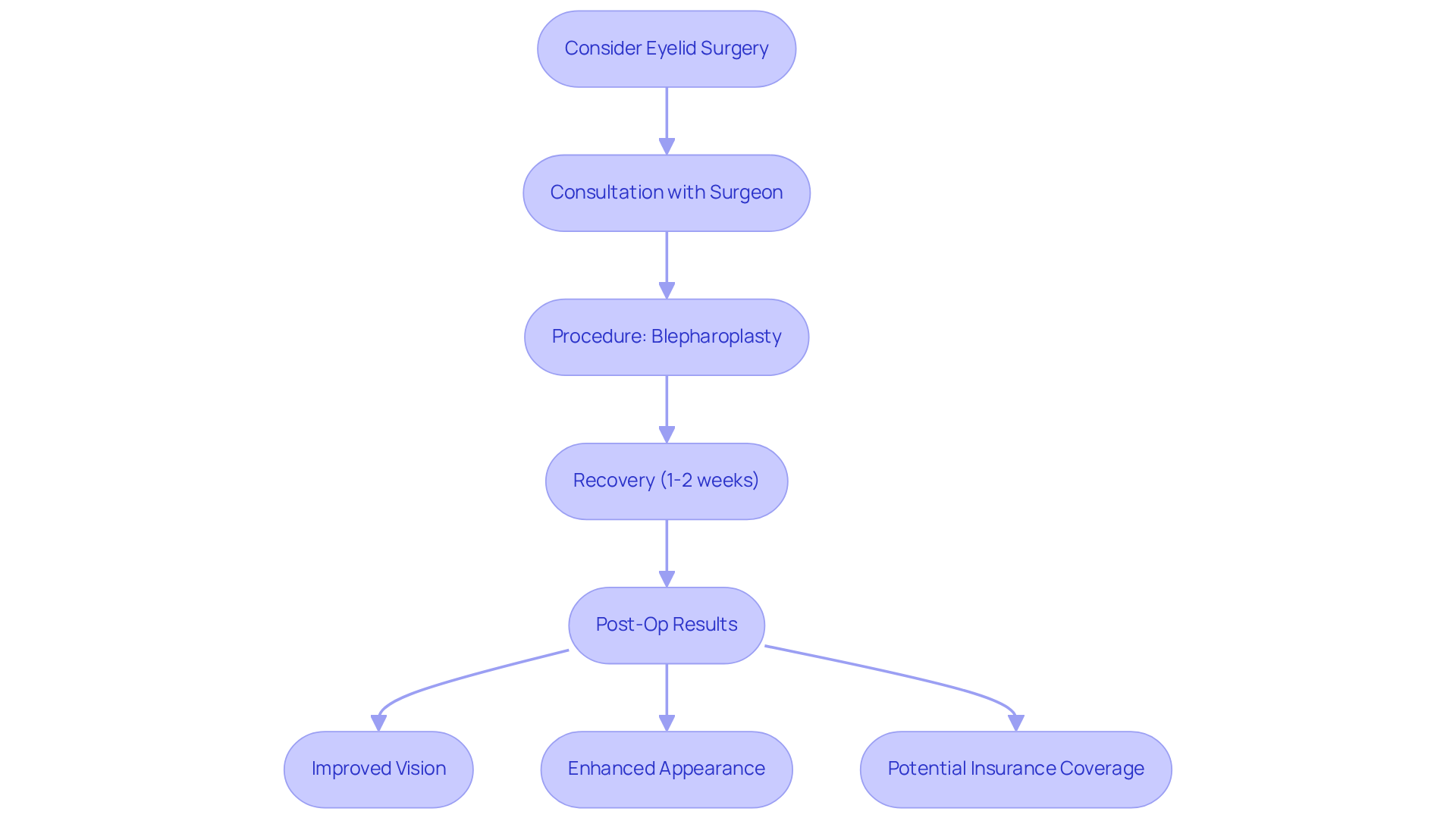
Utilize Cosmetic Procedures: Enhancing Eyelid Appearance
Cosmetic procedures, particularly Botox and dermal fillers, have become valuable options for those seeking to enhance the appearance of their heavy eyelids. We understand that many individuals may feel self-conscious about sagging skin around their eyes. These non-invasive treatments can elevate the brow and reduce the look of drooping skin, offering instant rejuvenation with minimal recovery time. Patients often notice significant improvements shortly after the procedure, making these choices appealing for those who wish to refresh their eye area without undergoing surgery.
Botox is well-known for its muscle-relaxing properties, which can significantly reduce the appearance of heavy eyelids by targeting the muscles that contribute to sagging. Typically, the effects last for three to four months, requiring regular maintenance to sustain results. Dermal fillers, conversely, help restore volume and contour to the eyelid area, with results lasting around six to twelve months. Together, these treatments can create a more youthful and vibrant appearance, addressing common concerns like sagging and dark circles around the eyes.
We are encouraged by recent case studies that highlight the effectiveness of these procedures. Many patients have shared their positive experiences with non-surgical methods. For instance, the ongoing clinical trial NCT04831047 is examining the effects of the FDA-approved eye drop Upneeq, which has shown significant improvement in upper eyelid height and visual fields. As the popularity of these procedures continues to grow, they represent a comforting trend in cosmetic enhancements, appealing to those looking for subtle yet impactful improvements in their appearance.
However, it’s important to consider potential side effects of Botox, such as temporary facial weakness or drooping eyelids. We want to ensure that you are fully informed before making any decisions. This information is particularly relevant for individuals with cataracts who may have specific concerns about the appearance of their eyelids. Remember, we are here to help you through this process, providing support and guidance every step of the way.
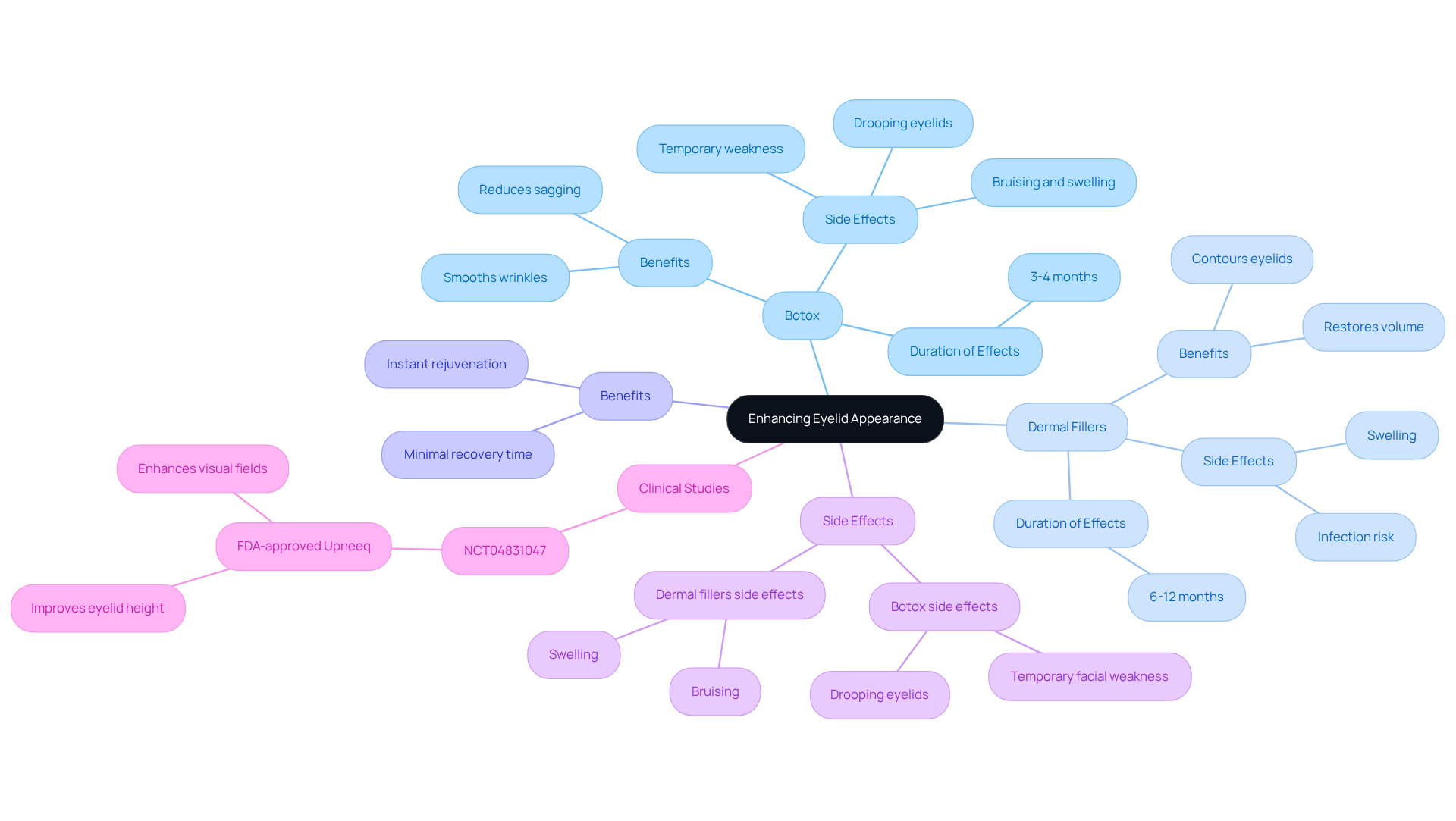
Consult Professionals: Tailored Solutions for Heavy Eyelids
Consulting with an ophthalmic surgeon or a qualified eye care professional, such as Dr. Ijeoma S. Chinwuba or Nicholas J. Schmitt, M.D. at Northwest Eye Clinics, addressing heavy eyelids is essential for effective treatment. We understand that this can be a concern for many, and these specialists perform comprehensive assessments to comprehend your unique needs. This enables them to explore a variety of solutions that encompass both medical and aesthetic issues.
Personalized care plans are crucial. They ensure that interventions are tailored to your specific circumstances, which can make a significant difference in your experience. Research shows that individuals who engage in personalized care often enjoy much better outcomes, including increased self-assurance and satisfaction with their appearance.
Furthermore, case studies demonstrate that people with heavy eyelids receiving customized therapies frequently report substantial improvements in both vision and appearance. This thorough approach not only addresses the physical aspects of heaviness around the eyes but also contributes positively to your overall health. It is a vital step in your eye care journey, and we are here to help you through this process.
Educate Yourself: Understanding Heavy Eyelids and Treatment Options
Understanding heavy eyelids and conditions such as ptosis is essential for your well-being. We understand that a drooping upper lid can be concerning. Ptosis occurs when the upper lid falls to a lower position than usual, potentially covering part of the pupil and interfering with your vision. Resources such as the Eye Condition Library and consultations with eye care professionals can provide valuable information to help you navigate this issue.
It’s common to feel worried about the consequences of neglected heavy eyelids, which can lead to vision problems and cosmetic concerns. Understanding these issues can motivate you to seek prompt assistance. Approximately 4.2 million Americans over the age of 40 are visually impaired, highlighting the significance of addressing drooping eyelids. By interacting with eye care specialists through consultations, you can enhance your awareness and improve your outcomes.
As Dr. Johns wisely notes, “If you don’t know if you’re a candidate or not, it doesn’t hurt to come out and get a consult and get checked out.” Acknowledging the potential dangers linked to heavy eyelids can empower you to take proactive steps in managing your eye health. We encourage you to think about arranging a consultation or using the Eye Condition Library for additional details on available options. Remember, we are here to help you through this process.
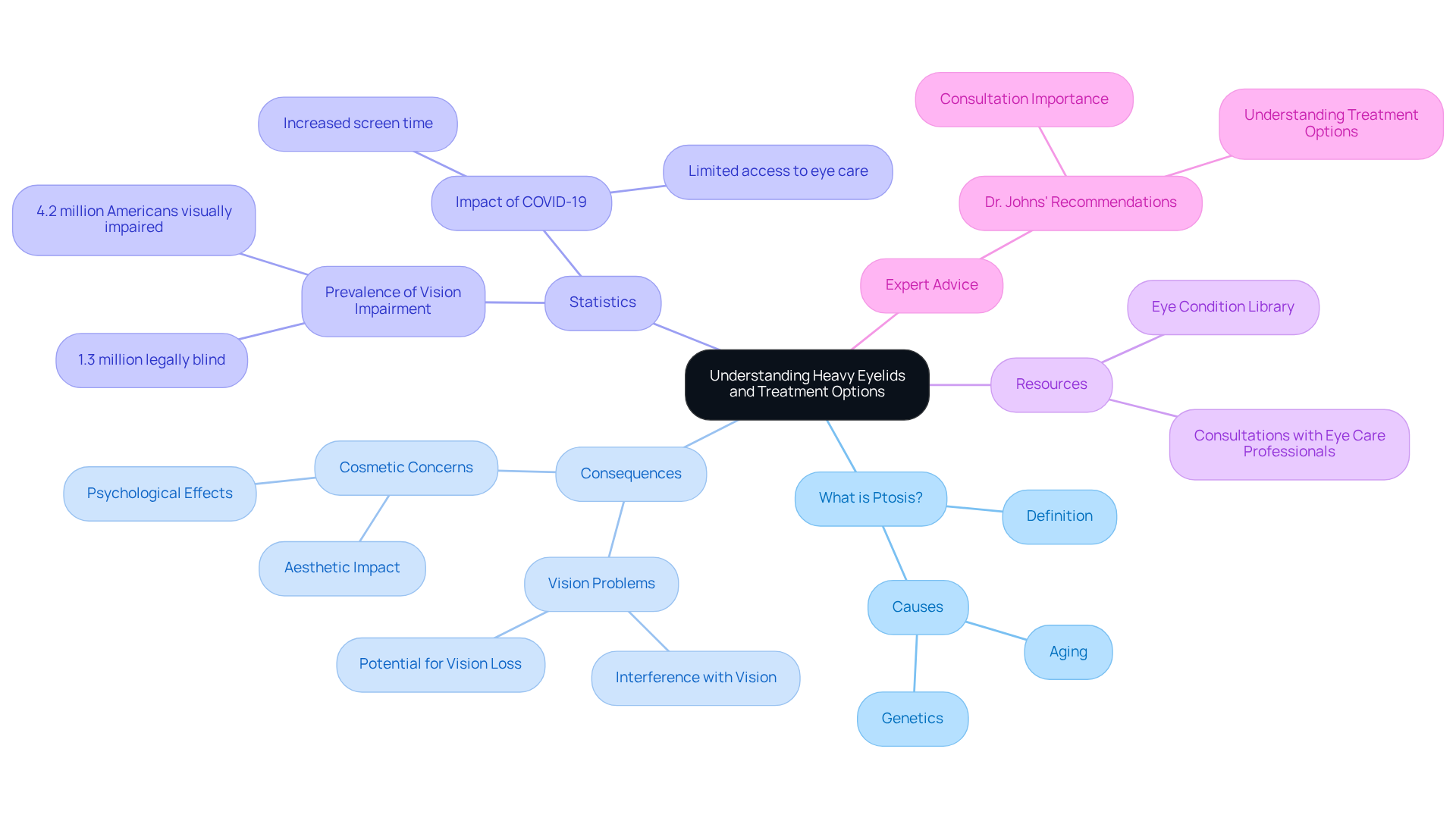
Prioritize Follow-Up Care: Monitoring Recovery from Treatments
After addressing the issue of heavy eyelids, whether through surgical or non-surgical methods, we recognize that prioritizing follow-up care is essential for your peace of mind. Regular check-ups allow your healthcare providers to monitor your recovery effectively, assess treatment outcomes, and address any emerging concerns. This continuous support is vital for ensuring optimal outcomes and enhancing your satisfaction.
Statistics show that over 93% of individuals express high satisfaction after undergoing eyelid surgery, often experiencing increased confidence and a more youthful appearance. It’s common to feel at ease venturing out in public within 10 to 14 days after surgery. Moreover, studies indicate that complications occur in fewer than 10% of cases, with most issues being temporary and resolving quickly.
We recognize that monitoring your recovery through regular consultations not only helps in identifying unusual signs, such as increased swelling or infection, but also serves as a motivational reminder of the progress you’ve made during healing. Capturing daily images during your recovery can assist in visually tracking your healing journey, providing important context for consultations and enabling you to visualize your recovery timeline.
By adhering to post-operative care instructions, including avoiding strenuous activities for about a week, and maintaining open communication with your healthcare providers, you can significantly enhance your recovery experience. Remember, we are here to help you through this process and support you in achieving your desired aesthetic and functional improvements.
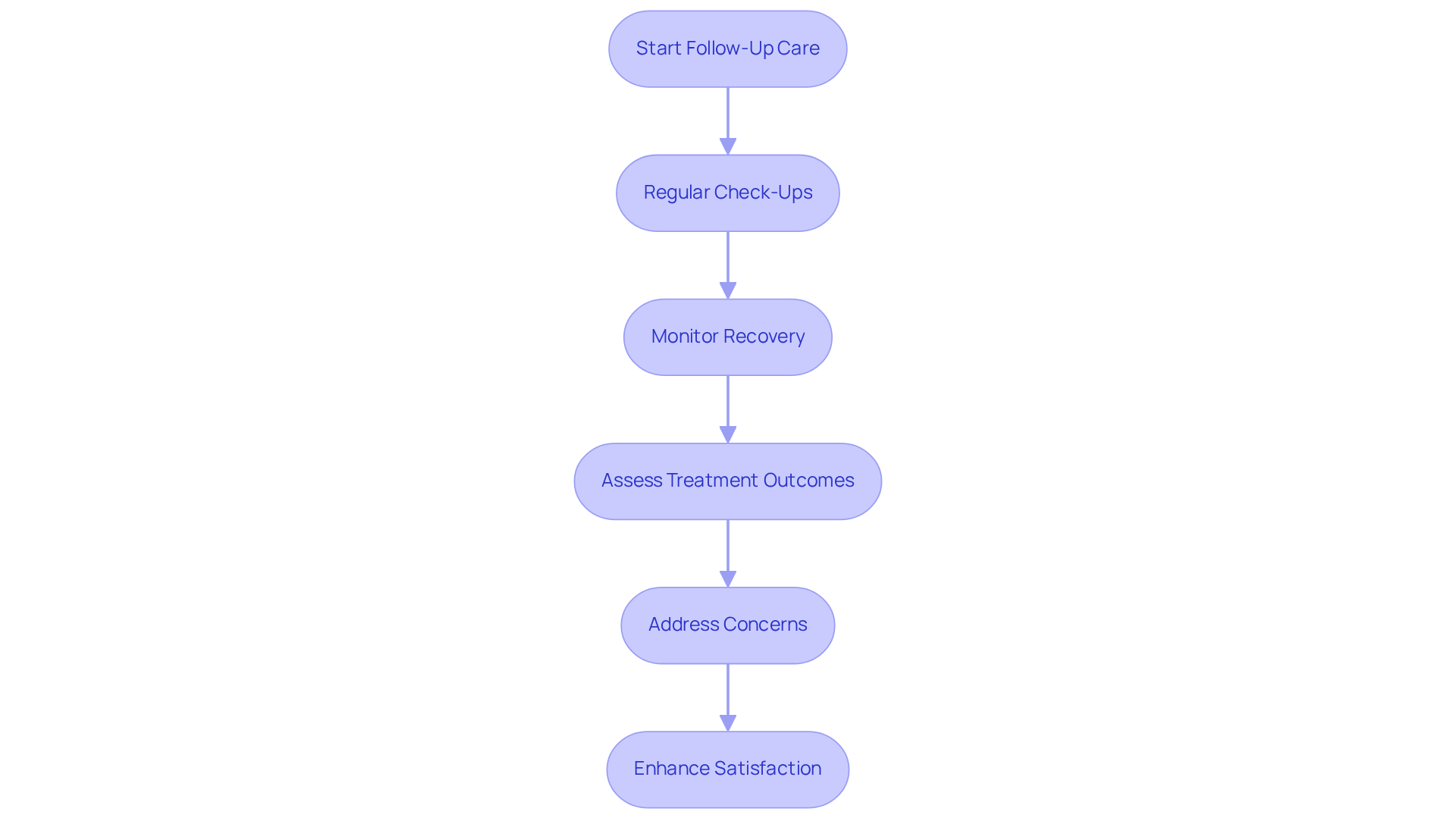
Recognize Risks: Complications of Untreated Heavy Eyelids
Untreated heavy eyelids may result in serious complications, including vision impairment, eye strain, and fatigue. We understand that conditions like ptosis, marked by heavy eyelids, can gradually worsen and may even result in irreversible vision loss if left untreated. It’s important to know that studies indicate untreated ptosis can lead to amblyopia, or lazy eye, especially in children. This highlights the critical need for early intervention.
According to the Royal Children’s Hospital, ‘the most obvious sign of ptosis in children is the drooping lid itself,’ which can interfere with both vision and development. We recognize how concerning this can be for parents. Additionally, dermatochalasis, which involves excess skin around the eyes, can hinder peripheral vision and cause discomfort. Ignoring these symptoms not only risks worsening the condition but also may lead to chronic discomfort and functional impairment.
For many, surgical intervention for ptosis becomes essential to restore proper positioning and function. We want to reassure you that addressing these issues early can prevent considerable visual impairment. Recognizing these risks underscores the importance of seeking timely medical intervention to safeguard your overall eye health. Remember, we are here to help you through this process.
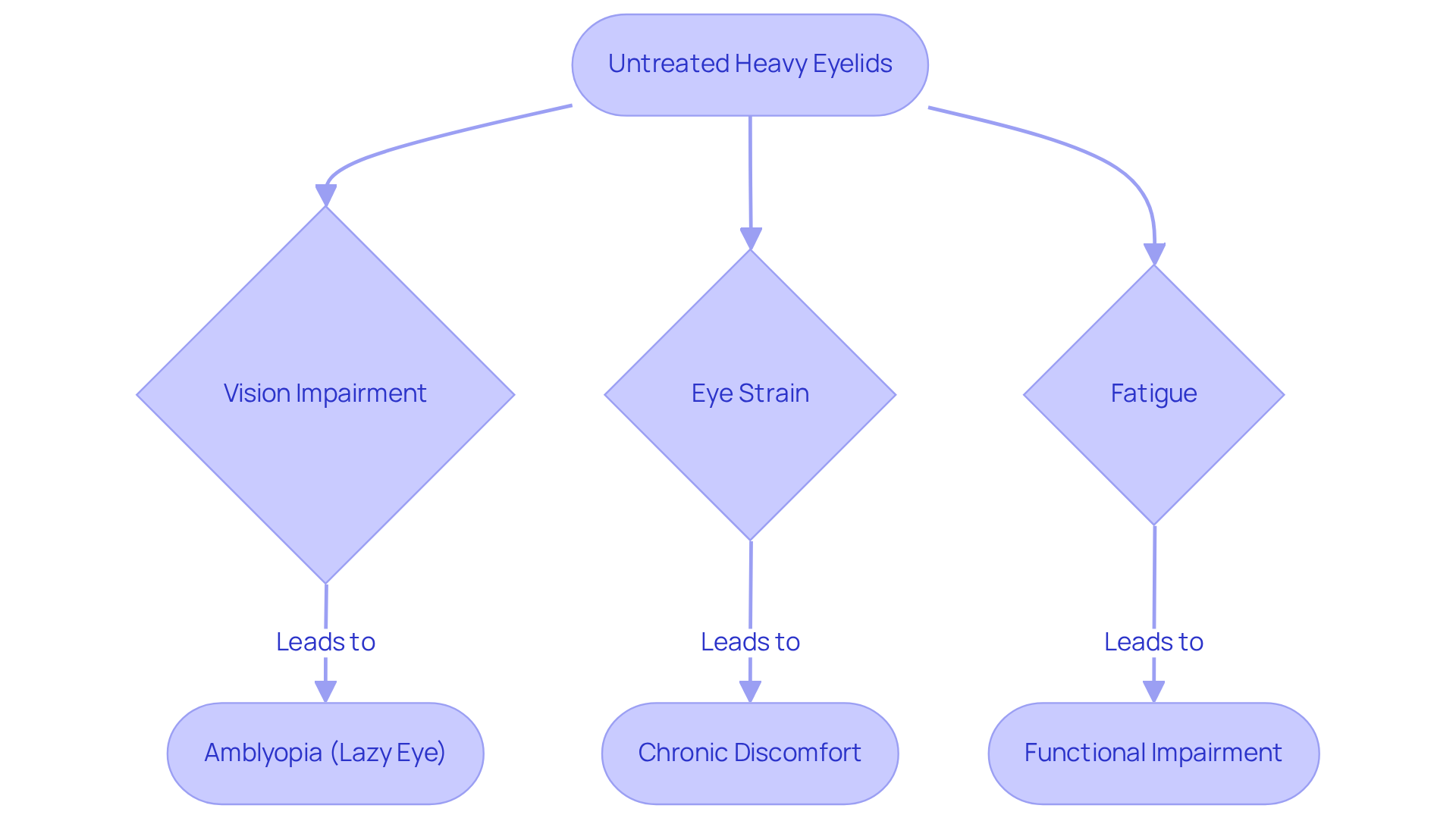
Seek Timely Intervention: Addressing Heavy Eyelids Early
Recognizing symptoms of heavy eyelids, including drooping or impaired vision, is essential for maintaining your eye health. We understand that noticing these changes can be concerning. Conditions like ptosis and dermatochalasis can lead to heavy eyelids and worsen over time, making early diagnosis and care essential. Seeking professional advice not only helps in managing these symptoms but also significantly improves your quality of life.
Eye care professionals emphasize that timely intervention can lead to better patient outcomes. Imagine regaining comfort and clarity in your vision—it’s possible with the right care. Don’t delay in consulting with an expert; we are here to help you explore your treatment options and take proactive steps toward enhancing your eye health.
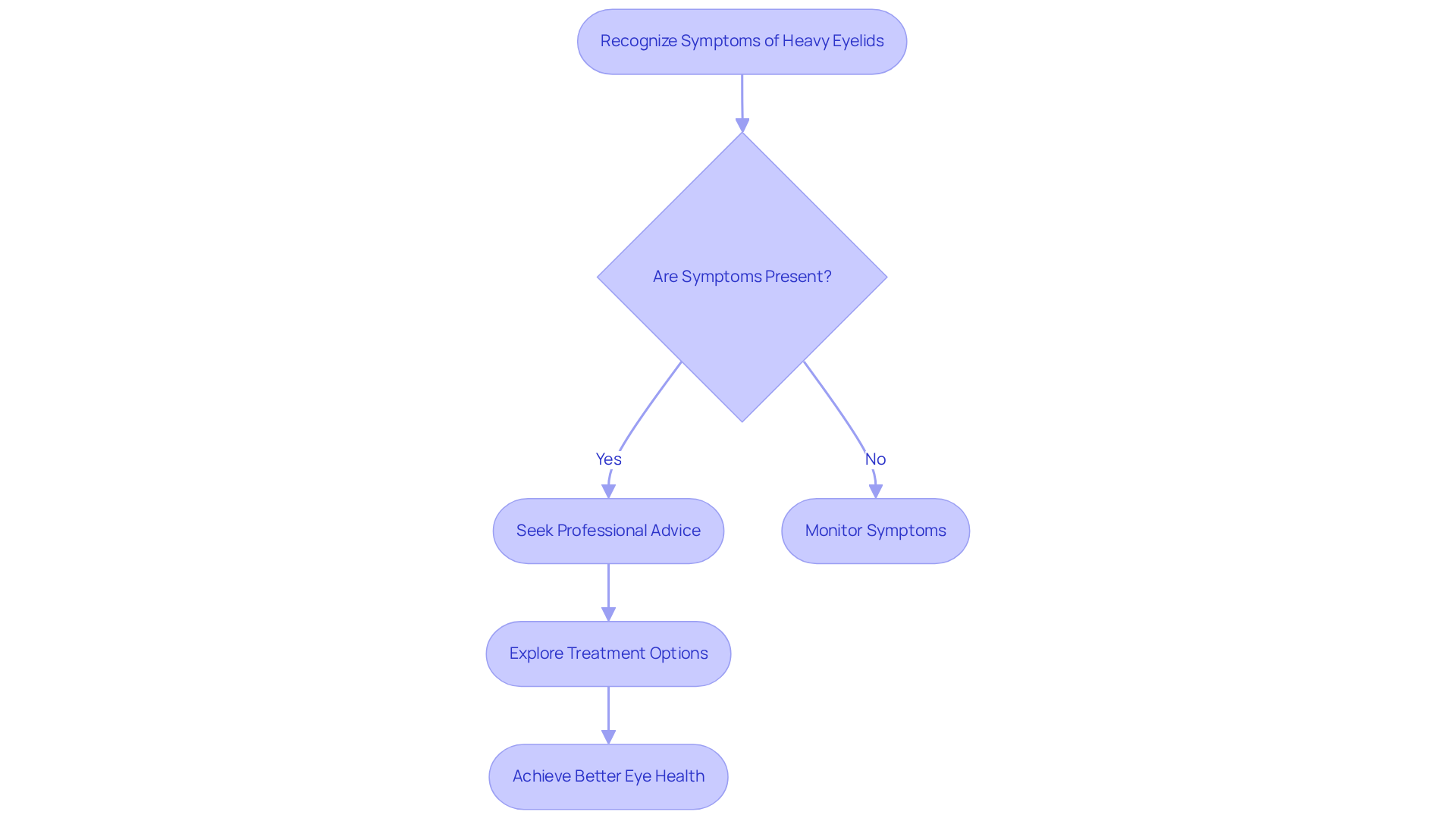
Conclusion
Understanding and managing heavy eyelids is essential for both aesthetic and functional reasons. We understand that this can be a source of concern for many individuals. The article highlights a range of effective solutions, from surgical options like blepharoplasty to non-surgical treatments such as Upneeq eye drops and lifestyle adjustments. Each approach offers unique benefits, ensuring that you can find a tailored solution that meets your specific needs and preferences.
Key points discussed include:
- The importance of recognizing the underlying causes of heavy eyelids, which can range from aging and genetics to health conditions like ptosis.
- It’s common to feel overwhelmed by these factors.
- The significance of consulting with professionals to explore personalized care plans that address both medical and cosmetic concerns.
- The value of follow-up care and monitoring recovery, ensuring optimal outcomes and satisfaction for those who undergo treatment.
Ultimately, taking proactive steps to address heavy eyelids can lead to significant improvements in both appearance and quality of life. Seeking timely intervention not only helps in managing symptoms but also prevents potential complications associated with untreated conditions. By prioritizing your eye health and exploring available treatment options, you can regain confidence and clarity in your vision. We are here to help you through this process.
Frequently Asked Questions
What treatments are available for heavy eyelids at Northwest Eye?
Northwest Eye offers a range of treatments for heavy eyelids, including surgical options like blepharoplasty, which removes excess skin and fat, and non-surgical options like Upneeq, an FDA-approved eye drop that temporarily lifts heavy eyelids.
What is blepharoplasty and what benefits does it provide?
Blepharoplasty is a surgical procedure that removes excess skin and fat from the eyelids, enhancing both appearance and functionality. It refreshes the look of the eyes and improves peripheral vision.
What is Upneeq and how does it work?
Upneeq is an FDA-approved eye drop that provides a temporary lift to heavy eyelids. It is a quick and effective non-surgical solution for individuals seeking immediate results.
How does Northwest Eye tailor treatment plans for patients?
Northwest Eye focuses on patient-centered care, tailoring every treatment plan specifically to individual needs, enhancing vision and overall eye health while addressing personal concerns.
Are there financial options available for treatments at Northwest Eye?
Yes, Northwest Eye offers various financing options to make eye exams, vision tests, and treatments more accessible for patients.
What causes heavy eyelids?
Heavy eyelids can result from factors such as aging, genetics, health issues like ptosis (droopy upper eyelids) and dermatochalasis (excess skin), as well as lifestyle choices such as lack of sleep and excessive screen time.
What lifestyle changes can help alleviate heavy eyelids?
Improving sleep quality, reducing screen time, and engaging in regular eye exercises can help enhance comfort and function. Additionally, using cold compresses or green tea bags can soothe the area and reduce puffiness.
Is there support available for patients considering eyelid surgery?
Yes, Northwest Eye provides support and guidance for patients considering eyelid surgery, ensuring they feel supported throughout the process.






